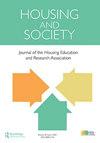迈向健康之家:调查2019冠状病毒病大流行期间食物流动和家庭空间实践的转变
Q2 Social Sciences
引用次数: 3
摘要
摘要:本文研究了2019冠状病毒病疫情期间食物流动引发的家庭空间实践转变。特别是,它认为,在整个大流行期间,由于需要保持身体距离而导致食物流动的变化,导致了有关消费、采购和准备的日常做法模式的变化。这种变化可以在家庭空间安排中观察到,其中食物流动与清洁协议交织在一起。本文研究了印度尼西亚新冠肺炎确诊病例最多的大雅加达地区在隔离后第一个月的国内食物流动及其空间安排。食物流动的映射是根据对15个城市家庭家庭的采访构建的,并辅以家庭食品实践的照片。食物的中断和长时间的流动在房屋的某些区域产生了三种循环模式和污垢的局部化:清洁,肮脏和中间,包括对室外空间的重新占用。对这些模式的理解强调了在处理新的健康威胁时空间实践的重要性,从而扩大了健康家庭的概念。本文章由计算机程序翻译,如有差异,请以英文原文为准。
Toward a healthy home: investigating food flow and the shift in domestic spatial practice during the COVID-19 pandemic
ABSTRACT This paper investigates the shift in domestic spatial practice triggered by the flow of food during the COVID-19 pandemic. In particular, it argues that the change of food flow due to the need for physical distancing throughout the pandemic resulted in the changing patterns of everyday practice concerning consumption, sourcing, and preparation. Such changes could be observed in the spatial arrangement of the domestic sphere, where the food flow is intertwined with cleaning protocols. This paper studies domestic food flow and its spatial arrangement during the first month of physical distancing in Greater Jakarta, a region with the most confirmed case of COVID-19 in Indonesia. Mappings of the food flow are constructed based on interviews with 15 urban domestic households and complemented by the photographs of domestic food practices. The interrupted and prolonged flow of food generated three patterns of circulation and localization of dirt in certain areas of the house: the clean, the dirty, and the in-between, including the re-appropriation of outdoor space. The understanding of these patterns highlights the importance of spatial practice when dealing with new health threats, thereby expanding the idea of a healthy home.
求助全文
通过发布文献求助,成功后即可免费获取论文全文。
去求助
来源期刊

Housing and Society
Social Sciences-Urban Studies
CiteScore
2.30
自引率
0.00%
发文量
10
期刊介绍:
Housing and Society is the journal of the Housing Education and Research Association (HERA). The journal supports the mission of HERA by providing for the dissemination of research and other scholarly work. Submissions from a broad range of perspectives are encouraged. Topics in housing include: policy, design, social aspects, gerontology, behavioral aspects, energy/environment, equipment, interiors, economics, theory/model development, education, and program development or evaluation. The journal welcomes the submission of original research articles, notes and commentaries. Notes are shorter manuscripts presenting succinct information on housing related to one of the following categories: - Research: exploratory or not heavily theory-based or statistically analyzed - Academic: innovative teaching ideas - Program: development, implementation, and/or evaluation of Cooperative Extension or other housing programming efforts - Policy: examination of policy impact, comparative analysis, and/or need to achieve housing goals - Reviews: books, documentaries, etc.
 求助内容:
求助内容: 应助结果提醒方式:
应助结果提醒方式:


